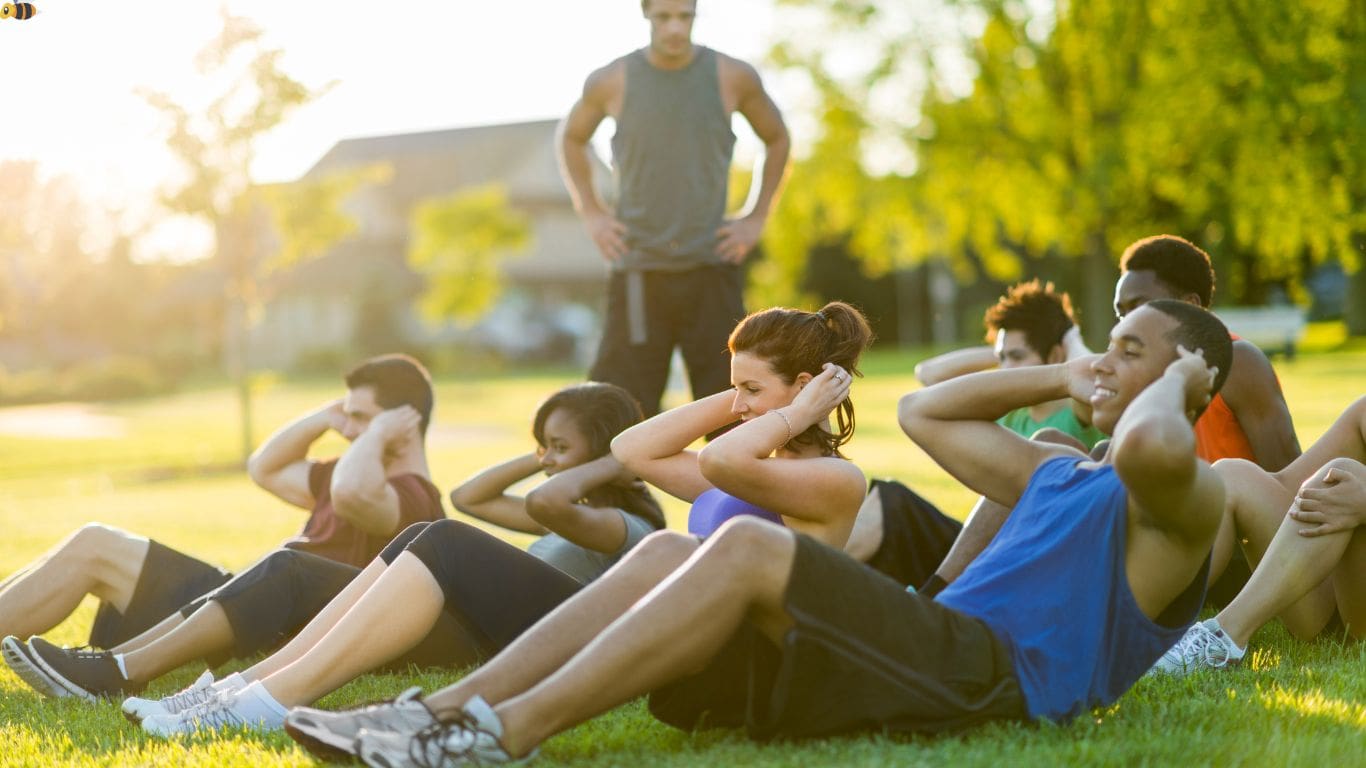
Maximizing the Benefits of Outdoor Fitness Training
Outdoor fitness training goes beyond traditional gym workouts. It combines physical activity with the benefits of nature, offering a holistic approach to well-being. This guide delves into the science behind outdoor exercise, explaining how it boosts physical health, mental clarity, and overall quality of life.
Discover practical tips, expert insights, and workout ideas to maximize your outdoor fitness journey.
What Are the Benefits of Outdoor Fitness Training?
Physical Health Advantages
Outdoor fitness training offers a unique set of physical benefits that go beyond what traditional indoor workouts can provide. The varied terrain and natural obstacles encountered outdoors challenge your body in ways that a flat gym floor simply can't match.
Cardiovascular Health: Outdoor activities, particularly those involving elevation changes or uneven surfaces, can significantly improve cardiovascular health. The heart works harder to pump blood to muscles navigating these varied terrains, leading to improved heart strength and efficiency. For instance, a study published in the Journal of Environmental Science by Dr. Jo Barton from University of Essex and Technology in 2010 found that outdoor runners experienced greater feelings of revitalization, increased energy, and decreased tension, anger, and depression compared to indoor treadmill users. Moreover, a research by Dr. Hannah Thompson from University of Exeter published at "International Journal of Environmental Research and Public Health" in 2018 showed that outdoor runners had lower heart rates and perceived exertion levels compared to treadmill runners, despite running at higher speeds outdoors.
Vitamin D Synthesis: One of the most significant advantages of outdoor exercise is the natural exposure to sunlight, which triggers vitamin D production in the body. A research conducted by Michael F. Holick, a professor of medicine, physiology, and biophysics at Boston University Medical Center in 2004 reports that sun exposure during outdoor activities can produce 10,000 to 25,000 IU of vitamin D in the skin, significantly more than the recommended daily allowance of 600-800 IU. This natural vitamin D production is crucial for bone health, immune function, and mood regulation. Vitamin D plays a crucial role in bone health, immune function, and mood regulation. Even short periods of sun exposure during outdoor workouts can help maintain adequate vitamin D levels, particularly important for those living in regions with limited sunlight.
Enhanced Muscular Engagement: The unpredictable nature of outdoor environments – from rocky trails to sandy beaches – engages a wider range of muscles than typically used in gym workouts. This comprehensive muscle activation improves overall strength, balance, and coordination. A study in the "Journal of Strength and Conditioning Research" found that running on natural terrain engages more muscle groups and burns 5-7% more calories compared to treadmill running. The uneven surfaces and varied terrains of outdoor environments challenge proprioception and balance, leading to improved overall strength and coordination.
Increased Calorie Burn: Outdoor workouts often lead to longer exercise duration and higher intensity due to the changing scenery and natural challenges. Research by Mr.Buyung-Alifrom Bangor University in 2010 did a systematic review and most studies reported greater enjoyment and satisfaction with outdoor activity with little evidence for differences in physiological measures between indoor and outdoor settings.
Mental Health and Cognitive Benefits
The impact of outdoor fitness or fitness retreat on mental well-being is profound and multifaceted, offering benefits that extend far beyond physical health.
Stress Reduction: Exposure to natural environments has been shown to lower cortisol levels, the body's primary stress hormone. A meta-analysis published in "Environmental Research" by Caoimhe Twohig-Bennett and Andy Jones from Norwich Medical School, University of East Anglia examined 143 studies and found that exposure to green space was associated with significant reductions in salivary cortisol, heart rate, and diastolic blood pressure, all indicators of lower stress levels.
Mood Enhancement: The combination of physical activity and nature exposure triggers the release of endorphins and increases serotonin levels in the brain. This neurochemical cocktail not only elevates mood but can also alleviate symptoms of anxiety and depression. A meta-analysis research published in Environmental Science & Technology by Jo Barton and Jules Pretty in 2010 demonstrated that even five minutes of exercise in a natural setting can improve self-esteem and mood.
Cognitive Function: Time spent in nature, coupled with physical activity, has been linked to improved attention spans, memory, and creative thinking. The Attention Restoration Theory suggests that natural environments provide a form of effortless attention, allowing our directed-attention mechanisms to replenish. A study in the Proceedings of the National Academy of Sciences by Gregory N. Bratman from Stanford University in 2015 found that participants who went on a 90-minute nature walk showed decreased activity in the subgenual prefrontal cortex, an area of the brain associated with rumination – a key factor in depression.
Enhanced Self-Perception: Outdoor exercise environments often present natural challenges that, when overcome, boost self-esteem and self-efficacy. Completing a challenging hike or mastering an outdoor yoga pose amidst natural beauty can foster a profound sense of accomplishment and connection with one's surroundings.
Practical and Social Advantages
Beyond the physical and mental health benefits, outdoor fitness offers practical advantages that can enhance overall quality of life.
Cost-Effectiveness: Outdoor exercise often requires minimal equipment and no gym membership, making it an economically accessible option for maintaining fitness. Natural features like hills, stairs, or even tree branches can serve as equipment for strength training and cardio workouts.
Social Connections: Many outdoor activities lend themselves to group participation, fostering social interactions and community building. Group hikes, outdoor fitness classes, or team sports in parks create opportunities for socializing and building support networks, which are crucial for long-term adherence to fitness routines.
Environmental Awareness: Regular engagement with natural environments through outdoor fitness can increase environmental consciousness and stewardship. This connection can lead to a greater appreciation for nature conservation efforts and more sustainable lifestyle choices.
How Can You Maximize the Benefits of Outdoor Exercise?
To fully harness the advantages of outdoor fitness, consider the following strategies:
Diversify Your Outdoor Activities
Incorporate a variety of outdoor exercises to challenge different aspects of your fitness and maintain engagement:
- Structured Workouts: Utilize park features for bodyweight exercises, create circuit training routines in open spaces, or join outdoor boot camp classes.
- Endurance Activities: Engage in hiking, trail running, or cycling to build cardiovascular endurance while exploring diverse landscapes.
- Water-Based Exercises: If accessible, try kayaking, stand-up paddle boarding, or open-water swimming for full-body workouts that also improve balance and core strength.
- Mind-Body Practices: Outdoor yoga or tai chi sessions can enhance the meditative aspects of these practices through connection with nature.
Adapt to Environmental Factors
Understanding and adapting to various environmental conditions can maximize the benefits and safety of your outdoor workouts:
Terrain Utilization: Leverage different terrains to target specific fitness goals. For instance, hill training can significantly improve leg strength and cardiovascular endurance, while beach workouts can enhance stability and lower body strength due to the unstable sand surface.
Weather Considerations:
- In colder months, layer clothing properly with moisture-wicking base layers, insulating mid-layers, and wind/water-resistant outer layers. Start with a thorough warm-up, potentially indoors, to prepare your body for the cold.
- In hot weather, schedule workouts during cooler parts of the day, stay hydrated, and wear light, breathable clothing. Be aware of heat exhaustion symptoms and take regular breaks in the shade.
Altitude Awareness: If exercising at higher altitudes, allow time for acclimatization. Start with lower intensity workouts and gradually increase as your body adapts to the reduced oxygen levels.
Safety and Preparation
Prioritize safety to ensure a positive outdoor fitness experience:
- Sun Protection: Apply broad-spectrum sunscreen with an appropriate SPF, wear protective clothing, and consider exercising during early morning or late afternoon to avoid peak UV hours.
- Hydration: Carry sufficient water, especially in hot or humid conditions. For longer activities, consider electrolyte replacement drinks.
- Equipment: Invest in appropriate footwear for your chosen activities to prevent injuries and enhance performance. For trail running or hiking, shoes with good traction are essential.
- Emergency Preparedness: Carry a basic first aid kit, especially for remote activities. Always inform someone of your planned route and expected return time for solo adventures.
Mindful Engagement with Nature
To fully reap the mental health benefits of outdoor fitness:
- Practice mindfulness during your workouts by focusing on your surroundings – the sounds, smells, and sights of nature.
- Periodically disconnect from technology to immerse yourself fully in the natural environment.
- Vary your workout locations to experience different natural settings, from urban parks to wilderness areas, keeping your routine fresh and engaging.
Conclusion
Outdoor fitness training offers a unique and powerful approach to improving both physical and mental well-being. By understanding and maximizing its benefits, you can transform your fitness routine into a more enjoyable, effective, and holistic experience. The natural world provides an ever-changing, challenging, and inspiring gym – one that not only strengthens your body but also refreshes your mind and spirit.
Step outside, breathe in the fresh air, and let nature be your partner in achieving your fitness goals and enhancing your overall quality of life.


